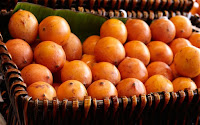The Achacha fruit, otherwise known as Garcinia humilis, has been cultivated for centuries in parts of the tropical Amazon Basin of Bolivia. A relative of the mangosteen, achachas are tangy in taste and often compared to the passionfruit. Achacha (meaning “honey kiss”) is bright orange when ripe, egg-shaped and grows up to 6cm long by 4cm in diameter.
Rich in vitamin C, Riboflavin, potassium, and also folate - achachas make a useful dietary aid to pregnant women, particularly as they are also lighter in sugar than many other fruits. Not only is the flesh good for you, but the skin is also packed with useful nutrients.
The Queensland Department of Agriculture, Fisheries and Forestry has found that the fruit keeps well for up to four to six weeks and is best kept out of the fridge, at room temperature.
Traditional uses of achacha
There may be little medical evidence to substantiate achacha’s more traditional uses, but this fruit has been used for centuries to help with the following:
- To suppress hunger - in Bolivia the skins are popularly used to ward off hunge.
- To extract its honey which is thought to contain healing properties. In its native Bolivia, achacha honey sells for 10 times the price of normal honey
- The inside of the skin is used to rub on marks (such as warts) on the skin to reduce them.
How to eat it
Add slices of Achachas to your fruit salads for extra tang or to baby lettuce leaves and serve with toasted almonds or pine nuts. Alternatively, freeze achachas for an natural sorbet treat for the kids.
Achacha also can be enjoyed as a refreshing, health-boosting drink. Blend the glossy orange rinds in a blender with water, and then once pureed and strained, dilute the juice and sweeten to taste.
“Excellent source of vitamin C and antioxidants to fight free radicals in the body. Achacha is also a good source of folate, which is especially important for pregnant women. They make a tasty addition to salads.”




0 comments:
Post a Comment